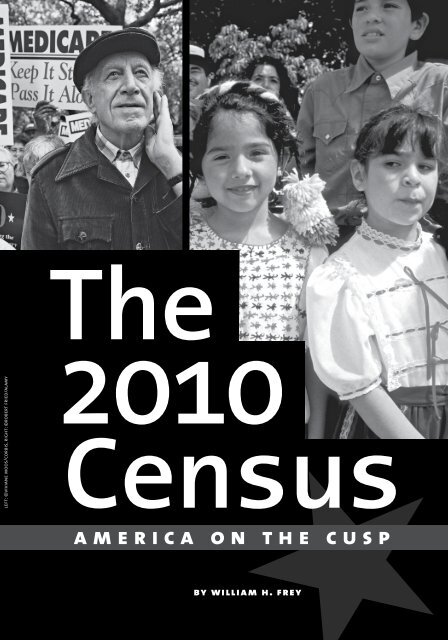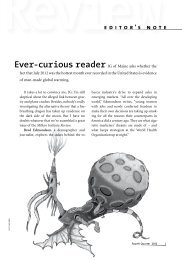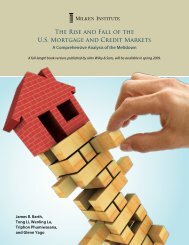The 2010 Census - Milken Institute
The 2010 Census - Milken Institute
The 2010 Census - Milken Institute
You also want an ePaper? Increase the reach of your titles
YUMPU automatically turns print PDFs into web optimized ePapers that Google loves.
left: ©viviane moos/corbis, right: ©robert fried/alamy<br />
tk <strong>The</strong><br />
<strong>2010</strong><br />
<strong>Census</strong><br />
america on the cusp<br />
by william h. frey<br />
Second Quarter 2012<br />
47
CCounting every resident of the United<br />
States is a monumental task. And last year,<br />
as the results of the latest national census<br />
dribbled out, demographers lined up to<br />
interpret their meaning. Only now, with<br />
the benefit of some time to analyze the<br />
findings, is the dramatic import of those<br />
statistics coming into focus: the next few<br />
decades will bring demographic changes<br />
that profoundly affect the nation’s culture,<br />
economy and politics.<br />
Bear in mind that the <strong>2010</strong> census form<br />
was the shortest in history – just 10 questions<br />
– because of the jettisoning of the 50-plusquestion<br />
long-form questionnaire that sought<br />
a wealth of details about income sources,<br />
bathroom facilities and the like. (Much of the<br />
information no longer collected so broadly<br />
will still be gleaned from the much smaller,<br />
but more frequently administered, American<br />
Community Survey.) Still, the answers to just<br />
those 10 remaining questions make plain that<br />
who Americans are, along with where and<br />
how they live, is changing radically.<br />
As anticipated, the population is growing<br />
more slowly, aging more rapidly and becoming<br />
more racially diverse from the bottom<br />
(that is, youngest) up. But the changes are altering<br />
the demographic characteristics of specific<br />
regions and localities in patterns that<br />
were not foreseen. <strong>The</strong> housing crisis, along<br />
with the subsequent recession and almost jobless<br />
recovery, has slowed some of these shifts.<br />
However, seemingly inexorable long-term<br />
trends will reshape the nation and its culture.<br />
growth is on the wane<br />
<strong>The</strong>re is good news here for those who have<br />
William H. Frey, a senior fellow at both the milken<br />
institute and the Brookings institution, specializes in<br />
demography.<br />
48 <strong>The</strong> <strong>Milken</strong> <strong>Institute</strong> Review<br />
U.S. POPULATION GROWTH<br />
18.5%<br />
7.3%<br />
1930-<br />
1940<br />
14.5%<br />
1940-<br />
1950<br />
1950-<br />
1960<br />
13.3%<br />
1960-<br />
1970<br />
11.5%<br />
1970-<br />
1980<br />
9.8%<br />
1980-<br />
1990<br />
13.2%<br />
9.7%<br />
1990-<br />
2000 2000-<br />
<strong>2010</strong><br />
bemoaned the relatively rapid growth of the<br />
U.S. population because they feared environmental<br />
damage or the economic burdens created<br />
by floods of impoverished immigrants<br />
(or both). Population growth in this century’s<br />
first decade was the slowest since the Great<br />
Depression – 9.7 percent, compared with 13.2<br />
percent in the 1990s. What’s more, the growth<br />
rate has continued to fall since the census was<br />
completed.<br />
This is a consequence of both short- and<br />
long-term factors. Not surprisingly, the recession<br />
affected the pace of immigration (legal<br />
and illegal) as well as current residents’ decisions<br />
to bear children. Indeed, the scarcity of<br />
jobs in construction, retailing and myriad<br />
low-skill services cut the flow of immigrants<br />
to far less than the million-a-year observed<br />
during most of the 1990s. By the same token,<br />
young people have put off marriage and<br />
childbearing in response to the horrible job<br />
market. And the birth numbers may never<br />
fully recover, because aging is continuing to<br />
shrink the share of women of childbearing<br />
age in the population.<br />
In contrast to many other advanced industrialized<br />
nations, though, U.S. population<br />
growth shows no signs of tanking. <strong>The</strong> fertility<br />
rate is still near the number needed to stabilize<br />
source: Author’s analysis of U.S. <strong>Census</strong> and the 2006 American Community Survey (all).
STATE POPULATION GROWTH 2000-<strong>2010</strong><br />
CA<br />
OR<br />
WA<br />
AK<br />
NV<br />
ID<br />
AZ<br />
UT<br />
the population in the long run. And unlike<br />
countries like Japan and Italy, the United States<br />
doesn’t face the challenge of a related issue:<br />
making do with a shrinking labor force. Nonetheless,<br />
those of us raised during the peak years<br />
of the baby boom are very unlikely to see that<br />
era’s growth rates replicated in our lifetimes.<br />
we’re moving inland<br />
While the national growth rate has slowed,<br />
sharp regional shifts in population continue to<br />
favor the Sun Belt. Unlike the past, though,<br />
Americans are moving away from the coasts,<br />
not toward them. While the three Sun Belt behemoths<br />
– California, Texas and Florida – continue<br />
to grow, they are no longer the only states<br />
on the move. <strong>The</strong> four fastest growing states in<br />
the past decade – Nevada (35 percent), Arizona<br />
(25 percent), Idaho (21 percent) and Utah (24<br />
percent) – are all in the Mountain West.<br />
This is reflected, of course, in the reappor-<br />
MT<br />
WY<br />
NM<br />
HI<br />
CO<br />
ND<br />
SD<br />
NE<br />
TX<br />
KS<br />
OK<br />
MN<br />
IA<br />
MO<br />
AR<br />
LA<br />
WI<br />
IL<br />
MI<br />
IN<br />
TN<br />
AL<br />
tionment of seats in the House of Representatives.<br />
Between 1950 and 1990, California,<br />
Texas and Florida accounted for two-thirds of<br />
the gains logged by the South and West. But<br />
between 1990 and <strong>2010</strong>, other Sun Belt states<br />
gained more seats than the Big Three. And in<br />
the <strong>2010</strong> census, California came up dry –<br />
even as Arizona, Nevada, Utah and Washington<br />
each gained a seat. Texas was still the biggest<br />
winner overall, gaining four seats. <strong>The</strong><br />
biggest congressional losers were Snow Belt<br />
states, in particular, New York and Ohio,<br />
which lost two seats each.<br />
Bear in mind that the census is a snapshot<br />
that masks volatile growth patterns within a<br />
boom-and-bust decade that culminated in<br />
the mortgage meltdown, the Great Recession<br />
and the lowest rates of internal migration<br />
since the end of World War II. Much of the<br />
growth of the South and interior West occurred<br />
during the housing-bubble years, only<br />
MI<br />
KY<br />
OH<br />
GA<br />
WV<br />
SC<br />
FL<br />
PA<br />
VA<br />
NC<br />
NY<br />
Second Quarter 2012<br />
VT<br />
NH<br />
MA<br />
CT<br />
NJ<br />
DE<br />
MD<br />
ME<br />
RI<br />
15%+<br />
10-15%<br />
5-10%<br />
0-5%<br />
Decline<br />
49
RACE AND ETHNICITY:<br />
SHARE OF<br />
<strong>2010</strong> POPULATION<br />
2+ Races: 1.9<br />
Other Race: 0.2<br />
Hawaiian: 0.2<br />
Asian: 4.7<br />
Am. Indian: 0.7<br />
SHARE OF 2000-<strong>2010</strong> GROWTH<br />
Hispanic:<br />
55.5<br />
White:<br />
8.3<br />
Black: 63.7<br />
Black:<br />
13.7<br />
Hispanic:<br />
16.3<br />
to fall off dramatically in the last part of the<br />
decade. <strong>The</strong> spectacular swoons in Las Vegas,<br />
Phoenix and Orlando slowed the loss of population<br />
in Los Angeles and New York, where<br />
high housing costs have been pushing Americans<br />
toward the more-affordable interior.<br />
Growth has not picked up in the boom-andbust<br />
interior cities in the year since the census,<br />
but probably will once the economy gets out<br />
of low gear.<br />
population growth<br />
means minority growth<br />
When we talk about population dynamics in<br />
contemporary America, we are largely talking<br />
about the impact of changes in race and ethnicity.<br />
<strong>The</strong> nation’s growth lull would have<br />
been far more pronounced had it not been for<br />
the ongoing infusion of new minorities. Be-<br />
50 <strong>The</strong> <strong>Milken</strong> <strong>Institute</strong> Review<br />
White:<br />
63.7<br />
Am. Indian: 0.7<br />
Asian: 15.9<br />
Hawaiian: 0.5<br />
Other Race: 0.5<br />
2+ Races: 5.0<br />
METRO AREAS WITH GREATEST<br />
WHITE LOSSES, 2000-<strong>2010</strong><br />
— 186,000<br />
San<br />
Francisco<br />
— 193,000<br />
— 195,000<br />
Chicago Detroit<br />
— 268,000<br />
Miami<br />
— 362,000<br />
Los<br />
Angeles<br />
— 559,000<br />
New<br />
York<br />
tween 2000 and <strong>2010</strong>, the population grew by<br />
27.3 million, but whites comprised only 2.3<br />
million of them – a mere 8 percent of the<br />
total. This compares with a white contribution<br />
of 20 percent in the 1990s and much<br />
higher shares in earlier decades. Meanwhile,<br />
Hispanics added 15.1 million and Asians 4.3<br />
million to their numbers, together representing<br />
71 percent of the population gain.<br />
Whites still make up 64 percent of the<br />
country, but the new minorities (including<br />
multiracial Americans) were crucial to the<br />
growth in all regions. <strong>The</strong>y accounted for all<br />
or most of the growth in 33 states – and not<br />
just in “melting pot” states like California and<br />
Texas, but in whiter, slower-growing states<br />
like Ohio, Nebraska and Iowa. <strong>The</strong> latter two<br />
were especially dependent on Hispanics for<br />
their growth.<br />
Minority growth dominated growth in the<br />
nation’s 100 largest metropolitan areas, where<br />
minorities contributed fully 98 percent of the<br />
decade’s net growth and now represent 43
METRO AREAS WITH WHITE MInORITy POPuLATIOnS, <strong>2010</strong><br />
White share of population shown in parentheses. Circles are shaded according to the most populous minority group:<br />
San<br />
Francisco<br />
(42%) Stockton (36%)<br />
Modesto (47%)<br />
San<br />
Jose<br />
(35%)<br />
Fresno (33%)<br />
Bakersfield (39%)<br />
Oxnard<br />
Las Vegas (48%)<br />
(49%)<br />
L.A. (32%)<br />
Riverside (37%)<br />
San Diego (48%)<br />
Albuquerque (42%)<br />
El Paso (13%)<br />
Honolulu (19%)<br />
San Antonio (36%)<br />
McAllen (8%)<br />
percent of the population. Indeed, 42 of these<br />
metropolitan areas registered absolute declines<br />
in white population between 2000 and<br />
<strong>2010</strong>, and minorities are now a majority in 22<br />
of them. While most of the “minority-majority”<br />
cities are in California, Texas and the<br />
Deep South, the list also includes the New<br />
York and Washington metropolitan areas.<br />
Changes in ethnic composition have been<br />
startlingly rapid in some areas: the minority<br />
share of Las Vegas’s population increased<br />
from 40 percent in 2000 to 52 percent in <strong>2010</strong>.<br />
Hispanics are now the largest minority in 52<br />
of the 100 largest metropolitan areas, up<br />
from 42 in 2000. All told, Hispanic populations<br />
more than doubled in 29 metropolitan<br />
areas, while Asian residents increased by<br />
more than half in 63 of them. Mexican-<br />
Americans, Asians and Indian-Americans –<br />
groups with very different labor-force profiles<br />
– have led the charge.<br />
Houston (40%)<br />
Memphis (46%)<br />
Jackson (48%)<br />
Hispanic<br />
Asian<br />
Black<br />
New York (49%)<br />
D.C. (49%)<br />
U.S. POPULATION GROWTH<br />
bY AGE, 2000-<strong>2010</strong><br />
(Percentage change over 10 years)<br />
11.3%<br />
19.5%<br />
Miami (35%)<br />
1.6%<br />
2.9%<br />
Under 15 15-24 25-34 35-44 45-54 55-64 65+<br />
— 9.0%<br />
50.3%<br />
Second Quarter 2012<br />
15.1%<br />
51
CHILD GROWTH (PERCENT)<br />
pervasive aging,<br />
selective younging<br />
<strong>The</strong> baby boomers have now reached advanced<br />
middle age and are knocking on the<br />
door of full-fledged seniorhood. Nearly 80<br />
million strong, this generation continues to<br />
inflate the size of the age niches it occupies.<br />
With the last boomers turning 45, the nation<br />
is facing a sharp divide between the rap-<br />
STATES WITH GREATEST GROWTH OF<br />
PRE-SENIORS (AGES 55-64), 2000-<strong>2010</strong><br />
HIGHEST GROWTH PERcEnT cHAnGE OvER dEcAdES<br />
1 alaska 92%<br />
2 Colorado 76%<br />
3 Utah 69%<br />
4 Washington 68%<br />
5 idaho 68%<br />
6 Oregon 67%<br />
7 Nevada 66%<br />
30%<br />
25<br />
20<br />
15<br />
10<br />
5<br />
0<br />
-5<br />
-10<br />
-15<br />
idly growing senior cohort and tepidly growing<br />
youth cohort. In the census decade, the<br />
number of people 45 and older grew by 26<br />
percent – 18 times faster than the under-45<br />
group! For the first time in history, over half<br />
the nation’s voting-age population is over 45.<br />
(Needless to say, they will have a similar impact<br />
on the size of the 65-74 population before<br />
2020.)<br />
<strong>The</strong>se trends are only beginning to affect<br />
localities. All parts of the country, but especially<br />
the fast-growing Sun Belt areas, will see<br />
a rise in their elderly population. This is no<br />
longer because older people are retiring there<br />
in large numbers, but because Snow Belt residents<br />
who emigrated in droves as young<br />
adults are aging in place. Large metropolitan<br />
areas that experienced the fastest growth (80<br />
percent-plus) in their age 55-64 populations<br />
included Austin, Raleigh, Boise City and Col-<br />
GROWTH AND DECLINES OF STATE CHILD POPULATIONS, 2000-<strong>2010</strong><br />
37.9 33.8 35.9 37.4 35.2 36.1 40.0 38.8 33.8 40.7 35.3 38.6 34.6 36.6 37.0 38.1 36.0 38.1 35.8 42.7 38.0<br />
39.1 38.9 37.4 36.0 37.9<br />
Alabama<br />
Alaska<br />
Arizona<br />
Arkansas<br />
California<br />
Colorado<br />
Connecticut<br />
Delaware<br />
D.C.<br />
Florida<br />
Georgia<br />
Hawaii<br />
Idaho<br />
Illinois<br />
Indiana<br />
Iowa<br />
Kansas<br />
Kentucky<br />
Louisiana<br />
Maine<br />
Maryland<br />
Massachusetts<br />
Michigan<br />
Minnesota<br />
Mississippi<br />
Missouri
orado Springs. Because boomers are aging in<br />
place everywhere, even stagnant localities like<br />
Youngstown, Buffalo and Cleveland had 30<br />
percent-plus growth in pre-seniors. <strong>The</strong> Snow<br />
Belt has had time to adjust to aging populations.<br />
That is not the case in many parts of<br />
the Sun Belt, which have yet to create the<br />
public and private infrastructure needed for<br />
oldsters.<br />
An even more surprising development is<br />
the emerging division between states that are<br />
losing children and those that are gaining them.<br />
Nationally, the under-18 cohort grew by a<br />
mere 2.6 percent over the decade. But 23 states<br />
(mostly in the Northeast, Midwest, Appalachia<br />
and the Deep South) registered absolute declines<br />
in child residents. <strong>The</strong> other 27 states<br />
(including Texas, Georgia, North Carolina, Arizona<br />
and Nevada) gained children, because<br />
they are magnets for young-adult migrants<br />
CHANGE IN CHILD POPULATION<br />
bY RACE/ETHNICITY, 2000-<strong>2010</strong><br />
White Black<br />
— 4,312,000<br />
39.8 36.2 36.3 41.1 39.0 36.7 38.0 37.4 37.0 38.8 36.2 38.4 40.1 39.4 37.9 36.9 38.0 33.6 29.2 41.5 37.5 37.3 41.3 38.5 36.8 Median Ages for States<br />
— 248,000<br />
Am.<br />
Indian<br />
— 39,000<br />
756,000<br />
26,000<br />
31,000<br />
Montana<br />
Nebraska<br />
Nevada<br />
New Hampshire<br />
New Jersey<br />
New Mexico<br />
New York<br />
North Carolina<br />
North Dakota<br />
Ohio<br />
Oklahoma<br />
Oregon<br />
Pennsylvania<br />
Rhode Island<br />
South Carolina<br />
South Dakota<br />
Tennessee<br />
Texas<br />
Utah<br />
Vermont<br />
Virginia<br />
Washington<br />
West Virginia<br />
Wisconsin<br />
Wyoming<br />
883,000<br />
4,789,000<br />
Asian Hawaii Other 2+<br />
Races Hispanic
2+ Races<br />
Others<br />
Asian<br />
Black<br />
Hispanic<br />
White<br />
PERCENT WHITE OF STATE CHILD POPULATIONS<br />
CA<br />
RACE/ETHNICITY bY AGE GROUP,<br />
U.S. POPULATION <strong>2010</strong><br />
Under<br />
5 years<br />
OR<br />
WA<br />
AK<br />
NV<br />
5-17<br />
years<br />
54 <strong>The</strong> <strong>Milken</strong> <strong>Institute</strong> Review<br />
ID<br />
AZ<br />
18-34<br />
years<br />
UT<br />
35-49<br />
years<br />
MT<br />
WY<br />
NM<br />
HI<br />
50-64<br />
years<br />
CO<br />
65-74<br />
years<br />
ND<br />
SD<br />
NE<br />
TX<br />
85+<br />
years<br />
KS<br />
OK<br />
100%<br />
80<br />
60<br />
40<br />
20<br />
0%<br />
MN<br />
IA<br />
MO<br />
AR<br />
LA<br />
WI<br />
IL<br />
MI<br />
IN<br />
TN<br />
AL<br />
MI<br />
KY<br />
OH<br />
GA<br />
Under 50%<br />
50-60%<br />
60-75%<br />
75% +<br />
WV<br />
from other states as well as immigrants.<br />
<strong>The</strong> nation’s pervasive senior growth, coupled<br />
with its divided child growth, is creating<br />
a demographic fault line demarcated by age.<br />
At the extremes are Maine (median age: 43)<br />
and Utah (median age: 29).<br />
kids and the emerging<br />
cultural generation gaps<br />
<strong>The</strong> sharp decline in the growth of the youth<br />
population reflects, in large part, the reality<br />
that an increasing proportion of whites are<br />
no longer of childbearing age. In fact, there<br />
was an absolute decline of 4.3 million white<br />
children nationwide, along with small declines<br />
in black and Native American children.<br />
All but four states showed absolute declines in<br />
white children over the 2000-<strong>2010</strong> decade, as<br />
did 86 of the 100 largest metropolitan areas.<br />
In most of the 27 states that, on balance,<br />
gained children, Hispanics made the differ-<br />
SC<br />
FL<br />
PA<br />
VA<br />
NC<br />
NY<br />
VT<br />
NH<br />
MA<br />
CT<br />
NJ<br />
DE<br />
MD<br />
ME<br />
RI
ence. Texas led all states in child gains, adding<br />
nearly one million – 95 percent of them Hispanic.<br />
In 12 states, mostly in the West and<br />
South, minority children outnumber whites.<br />
And in another 13, more than 40 percent of<br />
children are minorities. Minority children recently<br />
became the majority in Atlanta, Dallas,<br />
Orlando and Phoenix.<br />
<strong>The</strong> rapidly growing diversity of the children’s<br />
population stands in stark contrast to<br />
the largely white growth of the senior population.<br />
In effect, the nation’s diversity, bubbling<br />
up from the bottom of the age structure, has<br />
not yet reached the older segments of the<br />
population. <strong>The</strong> <strong>2010</strong> census revealed an important<br />
tipping point: nearly half (49.7 percent)<br />
of the nation’s infants are now the children<br />
of minority parents, and a quarter of<br />
them are Hispanics. Compare this to the age<br />
85-plus population, which is 85 percent<br />
white; the largest minority within these mostsenior<br />
seniors consists of blacks.<br />
Viewed in generational terms, there is an<br />
especially large cultural divide emerging between<br />
those under age 35 (40 percent minority)<br />
and those over age 50 (more than 70 percent<br />
white). Both the baby boomers and<br />
today’s seniors grew up in an era of low immigration,<br />
when the relatively small minority<br />
population was primarily black. By contrast,<br />
Americans under 35 came of age at a time in<br />
which racial mingling was the norm in classrooms,<br />
workplaces, dance clubs and churches.<br />
<strong>The</strong> resulting differences in social and political<br />
attitudes can only exacerbate economic<br />
sources of tension – in particular, who will<br />
pay for Social Security, Medicare and public<br />
education – between the young and the old.<br />
adios, ozzie and harriet<br />
Another benchmark recorded by the <strong>2010</strong><br />
census: for the first time, households headed<br />
by married couples were less than half the<br />
SHARES OF U.S. HOUSEHOLDS THAT ARE<br />
MARRIED COUPLES AND TWO-PARENT<br />
FAMILIES, 1950-<strong>2010</strong><br />
80%<br />
70<br />
60<br />
50<br />
40<br />
30<br />
20<br />
10<br />
0%<br />
1950 ’60 ’70 ’80 ’90 2000 ’10 1950 ’60 ’70 ’80 ’90 2000 ’10<br />
Married Couples Two-Parent Families<br />
total. Meanwhile, the number of marriedcouple-with-child<br />
households declined in absolute<br />
terms, and now represents just onefifth<br />
of all households. “Traditional” nuclear<br />
families, it seems, are no longer at the center<br />
of American life.<br />
<strong>The</strong> downturn in the married couples’<br />
share reflects a sea change since 1950, when<br />
they made up nearly four out of five households.<br />
<strong>The</strong> change has been driven by a mix<br />
of factors: greater financial independence for<br />
women, the rise of single-parent households,<br />
the inclination of young couples to live together<br />
without the benefit of wedding vows.<br />
Today, many more people, young and old, live<br />
alone, with unrelated people or in households<br />
headed by single people.<br />
<strong>The</strong> percentage of households of any kind<br />
with children is lower than it was in 2000, but<br />
only two-parent households declined in absolute<br />
terms. <strong>The</strong>re are still states, including<br />
Nevada, Utah, Arizona, Texas and Idaho, in<br />
which the number of two-parent households<br />
Second Quarter 2012<br />
55
100%<br />
80<br />
60<br />
40<br />
20<br />
0%<br />
RACE/ETHNICITY PROFILES FOR<br />
SUbURbS, 2000 AND <strong>2010</strong><br />
(many of them Hispanic) has grown. Indeed,<br />
the greater inclination of Hispanics to live in<br />
traditional families suggests the potential for<br />
a revival of what was once the cultural norm.<br />
However, the great majority of states are still<br />
registering substantial declines in these sorts<br />
of households.<br />
geographic reversals for blacks<br />
<strong>The</strong> new census pointed up two striking reversals<br />
in long-term trends for blacks that are<br />
changing racial demographics in America.<br />
One is blacks’ departure from non-Southern<br />
states and metropolitan areas – a 180-degree<br />
turn from the postwar migration to the North<br />
in the quest for better jobs. <strong>The</strong> second is an<br />
unprecedented black flight from cities to suburbs.<br />
Together, these patterns suggest that<br />
younger blacks are eschewing the segregated<br />
urban life of their parents and grandparents as<br />
they reach the middle class.<br />
While small numbers of blacks have been<br />
returning to the South since the 1970s, the<br />
most recent census was the first to document<br />
absolute losses for places that had earlier been<br />
black destinations – among them New York,<br />
Michigan and California. Meanwhile Florida,<br />
56 <strong>The</strong> <strong>Milken</strong> <strong>Institute</strong> Review<br />
Hispanic<br />
Others<br />
Asian<br />
Black<br />
White<br />
AGE PROFILES FOR SUbURbS,<br />
2000 AND <strong>2010</strong><br />
SOUTH SHARE OF U.S. bLACK POPULATION<br />
GROWTH, 1970-<strong>2010</strong><br />
100%<br />
80<br />
60<br />
40<br />
20<br />
0%<br />
Age 45+<br />
Age 25-44<br />
Age Below 25<br />
2000 <strong>2010</strong> 2000<br />
<strong>2010</strong><br />
1960-<br />
1970<br />
1970-<br />
1980<br />
1980-<br />
1990<br />
1990-<br />
2000<br />
Non-<br />
South<br />
South<br />
2000-<br />
<strong>2010</strong><br />
Georgia, Texas and North Carolina have all<br />
recorded substantial gains. All told, threequarters<br />
of the growth of the nation’s black<br />
population took place in the South. Atlanta<br />
has now surpassed Chicago as the metropolitan<br />
area with the second-largest black population<br />
(after New York).
<strong>The</strong> exit of blacks from large cities was also<br />
new in the <strong>2010</strong> census. Six decades after the<br />
onset of white flight to the suburbs, blacks are<br />
following. <strong>The</strong> core cities within the nation’s<br />
100 largest metropolitan areas registered an<br />
absolute decline in black residents. This occurred<br />
in non-Southern cities including Chicago,<br />
Detroit and New York, as well as in<br />
Southern cities, including Dallas and Houston<br />
– where all of the recent black growth in<br />
the metropolitan areas took place in the suburbs.<br />
Happily, these shifts are also associated<br />
with a modest wane in black-white residential<br />
segregation.<br />
suburbs are becoming<br />
less distinct<br />
Market researchers, politicians and the public<br />
are still inclined to lump suburbs together as<br />
a socioeconomic phenomenon. Suburbs are<br />
seen as predominantly white, with large numbers<br />
of children and lifestyles that are distinct<br />
from the rest of America. But the <strong>2010</strong> census<br />
makes clear this is no longer the case. Half of<br />
all Americans now live in suburbs. And, in aggregate,<br />
within the nation’s 100 largest metropolitan<br />
areas, a majority of Hispanics, blacks<br />
and Asians now live in the suburbs. <strong>The</strong> same<br />
is true of the foreign-born and poor, who are<br />
now more numerous in the metropolitan<br />
areas’ suburbs than in the central cities.<br />
<strong>The</strong> shifting racial dynamics of suburbs<br />
are especially striking. White gains have<br />
slowed since 2000, with the bulk of suburban<br />
growth coming from minorities. While the<br />
arrival of blacks is a factor, Hispanics accounted<br />
for nearly half of all the gains in large<br />
metropolitan areas’ suburbs; whites contributed<br />
just 9 percent. Whites are now just 65<br />
percent of suburban residents – almost the<br />
same as their share of the total population,<br />
and well below their 81 percent suburban<br />
share in 1990. In fact, there were absolute de-<br />
clines in white residents in the suburbs of 32<br />
of the 100 largest metropolitan areas.<br />
<strong>The</strong> generalization that suburbs are dominated<br />
by children and young adults is also becoming<br />
less true. <strong>The</strong> baby boom population<br />
is the first suburban generation. Now, as the<br />
boomers age in place, the suburbs are aging<br />
with them. Within the largest metropolitan<br />
areas, the suburbs house higher percentages<br />
of seniors and mature adults (and lower percentages<br />
of children) than the metropolitan<br />
areas’ cores.<br />
In <strong>2010</strong>, 40 percent of suburbanites in the<br />
big metropolitan areas were older than 45,<br />
compared with 34 percent in 2000. Meanwhile,<br />
in the last census decade, the number<br />
of children living in the suburbs of 34 of the<br />
100 largest metropolitan areas declined.<br />
In essence, the suburbs have become a microcosm<br />
of America. While some remain<br />
largely white, young and home to a lot of<br />
two-parent families with 2.3 children, most<br />
do not. To say “I live in the suburbs” means<br />
about the same thing today as saying “I live in<br />
America.”<br />
new demographics<br />
of the 21st century<br />
<strong>The</strong> 21st century will be one of slower population<br />
growth, but sharp shifts of population<br />
characteristics will make us a different country.<br />
One key driver is the phalanx of aging<br />
baby boomers that, while no longer at the nation’s<br />
demographic center, will continue to<br />
make its presence felt in the growing numbers<br />
of elderly.<br />
<strong>The</strong> second, more important driver is the<br />
rise of Hispanic and Asian minorities. <strong>The</strong><br />
change toward greater racial and ethnic diversity<br />
will continue upward from the bottom of<br />
the age distribution, leading eventually to a<br />
population with a more global perspective.<br />
Indeed, the <strong>2010</strong> census results suggest that<br />
Second Quarter 2012<br />
57
WHITE SHARE OF AGE GROUP POPULATION<br />
100%<br />
80<br />
60<br />
40<br />
20<br />
0%<br />
STATES WITH HIGH AND LOW CULTURAL GENERATION GAPS<br />
Arizona<br />
Nevada<br />
California<br />
America will become a majority-minority<br />
population well before 2042, the year in<br />
which such a shift had been projected.<br />
<strong>The</strong> juxtaposition of young, new-minority-<br />
driven growth against a stagnant, aging white<br />
population is occurring at different speeds in<br />
different regions. <strong>The</strong> most racially diverse<br />
and youthful populations are in fast-growing<br />
states of the West and South, where people<br />
are headed inland, away from the traditional<br />
coastal magnets.<br />
In contrast, large swaths of the country, including<br />
the non-coastal Northeast, the Midwest<br />
and parts of the old South, are observing<br />
slow growth or even declines in their youth<br />
populations while remaining home to large<br />
numbers of white baby boomers and seniors.<br />
<strong>The</strong> demographic profiles of these states will<br />
eventually converge with those of more diverse<br />
states. But in the interim, they will be<br />
adapting – often fitfully – to the changes<br />
going on elsewhere.<br />
To different degrees, regions are experiencing<br />
cultural generation gaps in both public<br />
and private arenas, creating conflict over is-<br />
58 <strong>The</strong> <strong>Milken</strong> <strong>Institute</strong> Review<br />
Under 18 Age 65+<br />
New Mexico<br />
Texas<br />
West Virginia<br />
Vermont<br />
Maine<br />
New Hampshire<br />
Kentucky<br />
sues that are important to young minorities<br />
(immigration reform, the quality of public<br />
schools, affordable housing) against those<br />
that are dear to boomers and seniors (medical<br />
and retirement benefits). <strong>The</strong> gaps will<br />
occur in communities of all sizes, but will be<br />
widest in states where the presence of young<br />
minorities is new and the race-ethnic profiles<br />
of the younger generation differ most from<br />
the older generation – like Arizona, Nevada,<br />
California and Texas. <strong>The</strong> diffusion of these<br />
minorities, initially widening cultural gaps<br />
and then burying them with sheer numbers,<br />
is a near certainty.<br />
<strong>The</strong> emergence of the culture generation<br />
gap, along with unprecedented shifts that are<br />
upending stereotypes about households, cities<br />
and suburbs and racial residence patterns,<br />
make clear that America is on the cusp of<br />
great cultural change. <strong>The</strong> demographic<br />
trends are accelerating, but in ways we can<br />
reasonably predict. This gives us some lead<br />
time to deal with both the challenges and opportunities<br />
they present. <strong>The</strong> time, one hopes,<br />
will not be squandered.<br />
m<br />
U.S.















